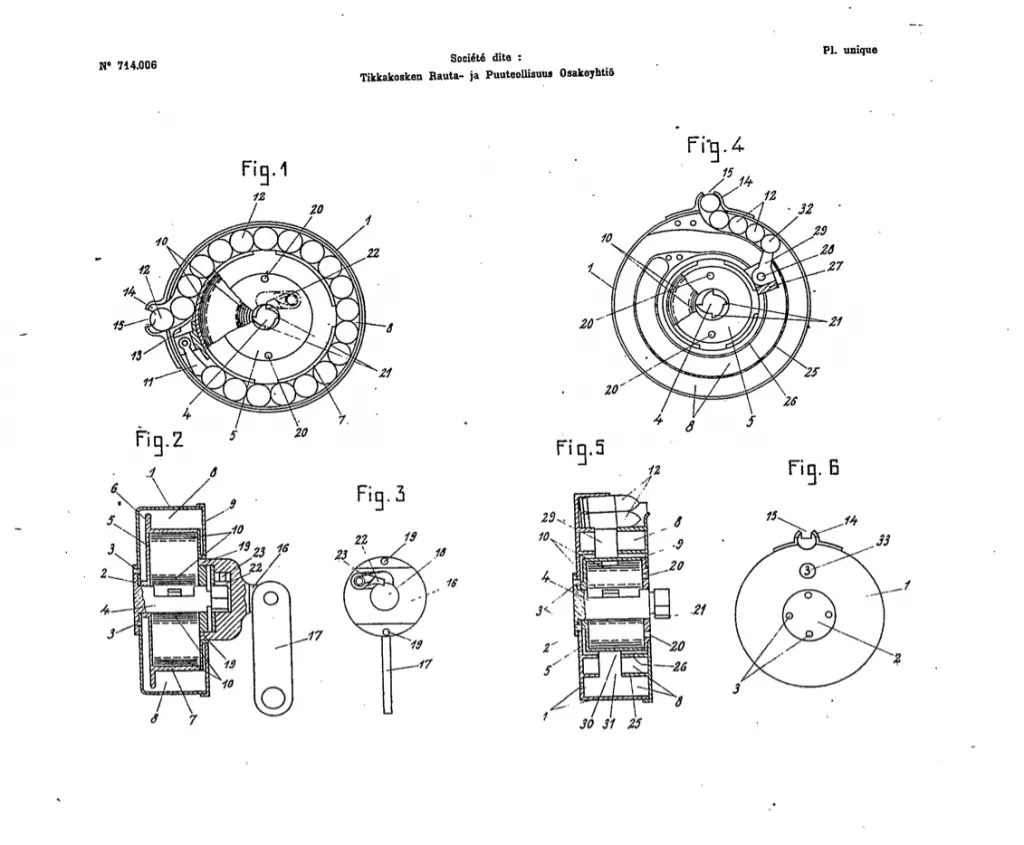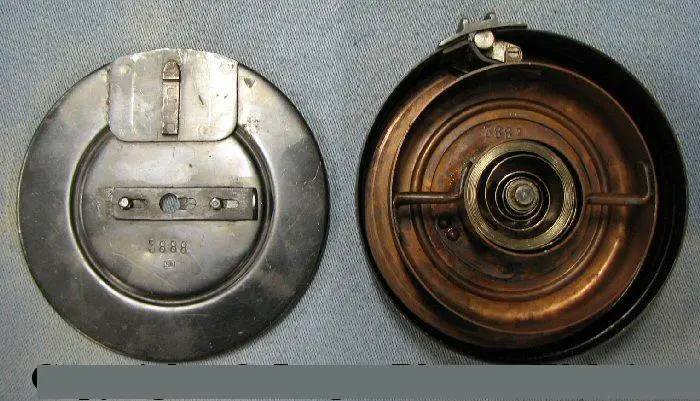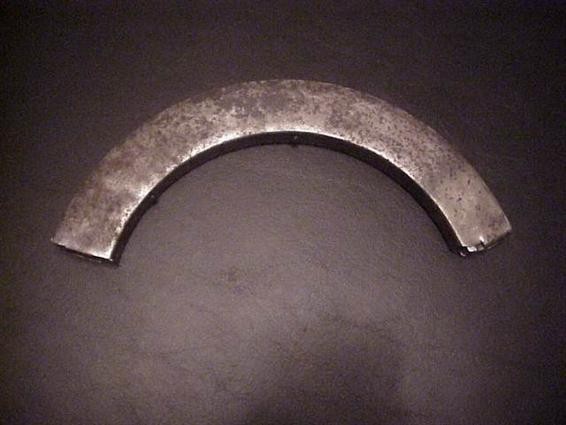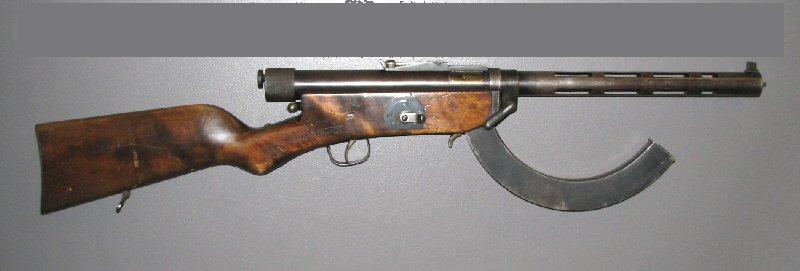Why this post?
Max Popenker kindly corrected our error with respect to the Suomi box magazine. Because the story of Suomi magazines is interesting, we thought we’d expand on it for the assembled multitudes, rather than just type a few corrective words in the original post.
Drum Magazines
In a comprehensive history of magazines on Small Arms of the World (subscription required, and recommended), which unfortunately only takes the drum back to 1917 and not to its origins in the world of mechanical machine guns, Leszek Ehrenfeicht describes the origin of the Suomi drum:
The other variation of the true drum was a design by Oskar Alfred Östmann of the Tikkakoski Oy, manufacturer of the Aimo Johannes Lahti’s Suomi submachine gun. It has a single follower, propelled by a very strong clockwork spring; necessary to overcome the weight and friction of the 70-round content of the drum. It was less complicated than Payne’s drum, but much more susceptible to dirt; increasing the friction and raising the burden on the clockwork spring even further. Despite that, it was the most widely mass-produced submachine gun magazine of the world. What, you never heard of Mr. Östmann and his magazine? What about Comrade Shpagin and his Pepesha drum? Oh, that you know? Well, that’s the same drum. The only difference was that Finns were the first, made it in 9x19mm and paid the inventor royalties, while the Soviets copied it in 7.62x25mm and never paid a dime – but that is another story.
By “the other variation,” Ehrenfeicht means by comparison to Oscar Payne’s L and C magazines for the Thompson SMG. He classifies these as “true drums,” as compared to snail drums (essentially a single-row mag with a coiled end) and further distinguishes them from helical (Calico, Bizon) or pan (Lewis, DP) magazines by the orientation of the cartridges.
The Östmann drum was the second Suomi design, and is the most common. The first one was allowed to open, like the Thompson drum or the Chinese 75-round AK/RPK drum, to allow the cartridges to be loaded, and was more complex and less reliable than Östmann’s.
The first Suomi design was almost certainly the drum magazine shown in Aimo Lahti’s 1932 US patent, US 1,867,513. (A patent we see Max has already found and put on the world.guns.ru site’s Suomi page). The patent was also published in multiple European nations including Germany, France, Britain, Belgium and Switzerland under various numbers on behalf of the Suomi’s maker, Tikkakoski. Lahti showed diagrams for both a cylindrical feed and a spiral one in his patent, and his drum requires an internal ratchet and external wrench, or external winding ratchet also shown in the patent (this image is from the French patent, the US patent uses the same drawings separated onto two pages). Note that the Suomi itself is also patented under US 1,895,719A. (The only other US patent Lahti has is for an improved recoil-locked machine gun mechanism that apparently never saw production, unless it was in one of his AA guns: US 1,987,939).
The early drum can be seen in some photos of early Suomis. In fact, a great French history of the Suomi has photos of the drum in its rare, cylinder-feed, 40-round variant:
(UPDATE: commenters A.A. and Chris Wardell have tracked the images on the French forum to the Finnish site, http://www.jaegerplatoon.net/MACHINEPISTOLS1.htm. Moreover, the text below on the M/26 that we translated from French to English seems to us to be lifted from the Jaeger Platoon site as well. We will request the site owner’s permission to use this content, but if he refuses his permission we will remove them, respecting his intellectual property).
This suggests that there never was a multi-follower, Paxton-style drum for the Suomi. (Bleg: does anybody know whence the French-speaker lifted the file? It looks like an original caption has been erased, and we’d like to give credit).
According to Frank Iannimico (same site, same login needed), the Russian PPSh submachine gun had a magazine very slightly different from the earlier, limited-production PPD-40 (the first Russian subgun to have a drum magazine. The even-rarer PPD-34 and -34/38 used curved box mags). The PPD’s original drum mag was a 73-round modification of the Suomi design, with a short “neck,” but by the time it reached production the neck was gone and the mag capacity was the final 71 rounds. The PPD and PPSh mags are identical, apart from the feed lips; one lip of the PPD’s is shorter to accommodate a protruding ejector in the receiver, and so PPD mags can be improvised from PPSh mags.
An experiment we haven’t tried is to use the Suomi drum in a PPSh or vice-versa. As the PPSh drums are a direct copy, and fed 9mm without drama in German and Finnish 9mm conversions, it’s possible, but the magazine catch appears to be in a slightly different position, requiring modification of mags, so that a truly interchangeable magazine would require a different catch.
The true origins of the “Coffin Clip”
As Max noted, the Coffin Clip originated not in Finland, but in Sweden. Ehrenfeicht again:
Another attempt at enlarging the magazine capacity was taken by Carl Schildstroem of Sweden. He designed a double compartment magazine with a single-position feed, giving, in effect, a four-row (twice the staggered row) single-position feed clip for 50 rounds. These were in fact two magazines sharing one set of magazine lips with a Schmeisser’s Cone. This magazine, called the “coffin clip” by the Finnish troops, was introduced for the Suomi SMG. It was too heavy (empty weight about 2 pounds), complicated, and failure-prone to be retained for service for any prolonged length of time. It was dropped soon after the war in favor of the wedge-shaped box. An interesting attempt at reviving the scheme was taken by the Italian company SITES for their M4 Spectre submachine gun. The M4 magazine also has a double compartment feature, but a two-position feed.
On the US Patent (2,217,848) the inventor’s name is spelled Schillstrom. It is heavy, in part because it’s built like a battleship, but our hands-on experience in firing a few hundred rounds and seeing a few thousand fired from coffin clips is that it’s actually reliable. The guns in question were very old and well-worn KP/31s that had been in use as training weapons in the US Army Special Warfare Center and School for over 30 years, and that had had some level of rebuild (as guns were refinished for the school, they got American anticorrosion finishes, in other words, parkerizing, in place of the factory bluing).
Loading the mag to capacity requires a loader or an application of physical strength using something (we used the edge of the loading table, basically a picnic table when we had more guys loading mags than we had loaders) to force the rounds down against the pressure of the followers, but not much more than an ordinary 32-round mag for a Sten or MP40 (each dual column has its own follower and spring in this design).
We did not have much luck running the coffin clips in the Swedish M45 Carl Gustav submachine gun, even though it ran flawlessly with its own 36-round wedge-section magazines. But the coffins worked fine in our sample of Suomis. Of course, our armorers had also had 30 years to fix them or cull them.
“Schmeisser’s Cone” is the term for the shape by which a dual- or multi-column box magazine squeezes the rounds into single-file for a single-position feed, because the first example was designed by Hugo Schmeisser in 1916 for an improved version of the MP. 18. It remained a toolroom experiment until after the war.
Dan Shea (same sub required) had an intermittent problem with a 50-round Suomi mag, in that he had live rounds stuck in a magazine that visually appeared clear. The Schillstrom design has three separate Schmeisser’s Cones, any one of which, or interaction between the two followers which should clear one another, might have caused Dan’s problem. (He suggests storing weapons without magazines in them, which looks less cool but is more safe).
And then there’s this oddball thing:
At first, we didn’t know what to make of it. This purported Suomi M/26 mag is for sale at GunBroker at the moment, at a very high price.
It is a double-feed magazine (as in the Thompson), but it’s curved like a Chauchat magazine. The claim is that it is:
[A] Finnish Suomi M/26 magazine in 7.65×22 caliber. This item shows some age and pitting but in good usuable condition. It is extremely rare.
We just don’t know enough to opine on the authenticity of this part. By 7.65 x 22, he must mean the round generally known as the 7.65 Parabellum or, in the USA, .30 Luger. The M/26 is an early, all-but-prototype Suomi.
Follow up on the Suomi M/26:
The excellent French page referenced above includes l’histoire of the Suomi, including the following:
Aimo Lathi a retravaillé son M/22…
OK, let’s do it en anglais (our translation, bearing in mind we do not do français for a living):
Aimo Lahti reworked his M.22 incorporating in it many improvements (all patented in Finland) making the submachine gun compatible with mass production.
The “konepistooliosakeyhtiö” was made by Ab Toool Oy in 100 copies, and in August 1924 the ministry of defense was interested in the submachine gun.
In February 1925, 30 examples were studied and tested by the armament commission of the MOD. The arm functioned properly, but the magazines were not interchangeable, and the barrels oxidized very rapidly.
In October 1925, the army requested 25 guns again, and 39 more in March 1936 and afterward decided to launch production of 100 examples. Most of these went to the army (60+) but some went to the Civil Guard and the border guards; conversely, very few of this series were exported (5 to Estonia). This model was called M/26.Aimo Lahti had succeeded in his gamble: not only did his submachine gun at least as well as the Bergmann, it cost much less (2,200 finnish marks vs. 4,500).
SUOMI M/26 (7,65 Kp/26)
Caliber : 7,65 x 21 Parabellum
Length : 930mm
Barrel : 350mm
Weight : 4,18 Kg
Cyclic rate of fire : 600 cps/min
Feed : detachable box magazine, 36 cartridges
Production : around 100 examples between1925 and 1926 (in addition to test guns)
The M/26 never really saw combat, as during the Second World War these guns were used by support troops behind the front.
In 1959 the 57 surviving M/26es were sold to Interarmco, something that would seem unlikely today for such a rare weapon.
Pretty neat — learned something we didn’t know previously, and found a page and a site full of new information.

Kevin was a former Special Forces weapons man (MOS 18B, before the 18 series, 11B with Skill Qualification Indicator of S). His focus was on weapons: their history, effects and employment. He started WeaponsMan.com in 2011 and operated it until he passed away in 2017. His work is being preserved here at the request of his family.





13 thoughts on “More on Suomi Magazines”
Re: the 40-round drum magazine image, a quick reverse Google image search turns up a rather likely original on this page: http://www.jaegerplatoon.net/MACHINEPISTOLS1.htm
I can’t imagine why anyone bothered to make a true drum, but not snail magazines.
The wasted space in the middle. Quite inefficient…
Easier to make it and have it work first time, perhaps. An interim design. There also was a 20-round-box that I’ve never seen even in a picture.
A.A. (and Chris) You’ve got it. Not only are the pictures lifted from Jaegerplatoon’s page, the French I wasted time translating into English is a direct translation of the English on the Finnish page. I have dropped a line to the owner of Jaeger Platoon asking his permission to keep the images up. If he says no they come down and links in their place.
This looks like the original page for that Suomi drum image:
http://www.jaegerplatoon.net/MACHINEPISTOLS1.htm
They blocked out the copyright notice…btw, lots of good images of these drums on google images, especially the ones where they show them open and loaded!
I’ve got the good fortune to shoot a Thompson 1928A1 and a tarted up MAC11A1 with Suomi coffin mags and drums on a regular basis. The suomi drum are FAR more elegant and a much more advanced design. I love my Thompson but it’s no comparison.
The TSMG L-drum can’t be topped off. It spews ammo and you can easily break the spring if you remove the cover with tension remaining on the spring. It you fire say, 10 rounds, and want to reload you have to thumb the remaining 40 out, open it, and reload all 50. The Suomi drums can be opened with tension still applied and can also be loaded to any level you desire vs the TSMG’s 0 or 50 options. Lastly, the way the Suomni rotates the entire ammo tray to feed the outter race and then uses the paw just for the inner race is a clever way to reduce friction.
The 50 round coffin mags are a work of art in my opinion. As someone who can’t weld worth a damn I appreciate the execution as well as the desgin. Much shorter and easier to carry than, say, a 50 round Lanchester mag.
Thanks, I’ve shot Thompsons a bit (once, for a hoot, we shot the old qualification table and wore the TSMG hanger on our rifle badges) but only with stick mags. We only had 1928s at the schoolhouse, with no drums, and everywhere else only M1s or no Thompsons. At the rental range I go to from time to time, it’s an M1 (well, technically an M1A1) so drums are right out. (For those not Thompson-savvy, the stick mags go in from the bottom, the drums from the side. Ingenious, and as far as I know, unique way to attach different kinds of magazines, although Lahti’s MG design in the last quoted patent would top-feed a pan mag or a box mag. The WWII military M1 and M1A1 lack the cuts to accept drums).
Interesting history. For what it’s worth your translation was pretty spot on even if it turned out to be a translation of a translation. The French one does seem to be a translated paraphrasing of the Jaegerplatoon article, itself written by what I would guess is a Finn. As a result, your translation ends up sounding more correct than the original which is always a funny result.
For the sake of French practice, I would make one small change:
“Aimo Lahti had succeeded in his gamble: not only did his submachine gun at least as well as the Bergmann, it cost much less…”
FROM
Lahti a réussi son pari puisque non seulement son pistolet mitrailleur fonctionne bien mais aussi puisqu’il coute moins cher que le Bergmann (2.200 Marks finlandais contre 4.500 Marks finlandais).
SHOULD BE
“Aimo lahti had succeeded in his gamble: not only because his submachine gun worked well, but also because it cost less than the Bergman…”
Also, now you’ve got me wanting to shoot a Thompson qual purely for the “what the hell is that?” factor, lol.
Thanks, Pete. It looks like I left out the word “worked” or any translation of the freakin’ VERB. Oversight… and the “much less” I was just wrong on, “moins cher que” is just “less expensive than” or dead-on, the archaic/British “less dear than”.
Re: TSMG qual. It was a team thing. Eight guys, three working M1s and the whole battalion’s quarterly .45 allocation… actually might have been another battalion’s, heh. And a keg in the team house — afterward.
here is a lovely drum. I crave it, tho will bring the total weight of M1a + sling + scope to c. 15 lbs. Perhaps WM could evaluate it. Next Xmas I am unblocking the chimney, in profound hopes
@ http://ustactical supply.com/m14m1a308highcapicitydrummagazine.aspx
sorry, @ ustacticalsupply.com/m14m1a308highcapacitydrummagazine.aspx
ok, I’ll get it right this time –
http://ustacticalsupply.com/m14m1a308highcapacitydrummagazine.aspx
X Products, a good mag. They make several 7.62 and 5.56 versions, and just introduced (or are introducing?) a new one in 9mm, which is the cat’s ass on an MP5.